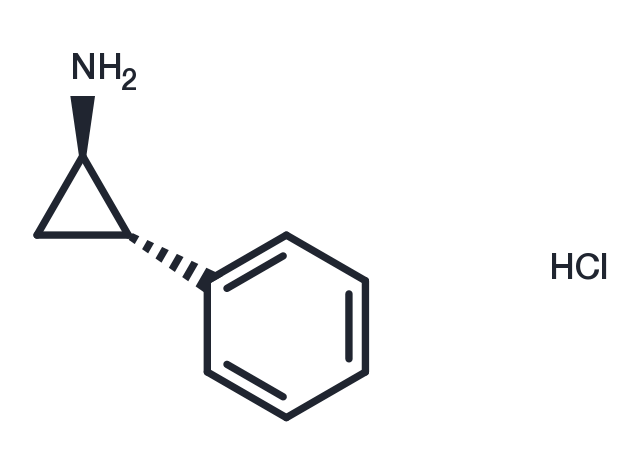Powder: -20°C for 3 years | In solvent: -80°C for 1 year


Tranylcypromine (2-PCPA) hydrochloride (SKF-385 HCl), a Monoamine Oxidase inhibitor, is effective in the treatment of major depression, dysthymic disorder, and atypical depression.

| Pack Size | Availability | Price/USD | Quantity |
|---|---|---|---|
| 100 mg | In stock | $ 39.00 | |
| 200 mg | In stock | $ 51.00 | |
| 1 mL * 10 mM (in DMSO) | In stock | $ 39.00 |


| Description | Tranylcypromine (2-PCPA) hydrochloride (SKF-385 HCl), a Monoamine Oxidase inhibitor, is effective in the treatment of major depression, dysthymic disorder, and atypical depression. |
| Targets&IC50 | LSD1:22.3 μM, MAO-A:11.5 μM, MAO-B:7 μM |
| In vitro | Compared with the control group, Tranylcypromine at dosages of 5 mg/kg and 10 mg/kg significantly and gradually increased muscle activity in male rats; however, a 2 mg/kg dosage of Tranylcypromine had no effect. Additionally, Tranylcypromine administered at 10 mg/kg markedly increased the number of copulatory behaviors in male rats. |
| In vivo | In bovine aortic endothelial cells, Tranylcypromine (500 μg/mL) markedly inhibits bradykinin-induced release of arachidonic acid. Additionally, Tranylcypromine suppresses the activity of CYP2A6 (IC50: 0.42 μM) and CYP2E1 (IC50: 3 μM) in human liver microsomes (HLMs), inducing type II and cyclopropylbenzene type I difference spectra in HLMs. Nicotine metabolism mediated by CYP2A6 in HLMs is completely inhibited by R-(+)-Tranylcypromine (Ki: 0.05 μM), (±)-Tranylcypromine (Ki: 0.08 μM), and S-(-)-Tranylcypromine (Ki: 2.0 μM). |
| Kinase Assay | PDE activity is determined with some modifications. The assay mixture contain 50 mM Tris (pH 7.4), 5 mM MgCl2, 0.5 μM cAMP or cGMP, and [3H]cAMP or [3H]cGMP (about 30,000 cpm/assay), the indicated concentration of the inhibitor and an aliquot of the enzyme solution at a final assay volume of 200 μL. Stock solutions of the compounds are diluted 1:100 (v/v) in the Tris buffer mentioned above; appropriate dilutions are prepared in 1% (v/v) DMSO/Tris buffer, which are diluted 1:2 (v/v) in the assays to obtain the desired final concentrations of the inhibitors at a DMSO concentration of 0.5% (v/v). DMSO itself affected none of the PDE activities. After preincubation for 5 min at 37°C, the reaction is started by the addition of substrate (cAMP or cGMP) and the assays are incubated for further 15 min at 37°C. Then 50 μL of 0.2 N HCl is added to stop the reaction and the assays are left on ice for about 10 min. Following incubation with 25 μg of 5′-nucleotidase (Crotalus atrox snake venom) for 10 min at 37°C, the assays are loaded on QAE Sephadex A-25 (1 mL of bed volume in Poly-Prep chromatography columns). The columns are eluted with 2 mL of 30 mM ammonium formate (pH 6.0) and the eluate is counted for radioactivity. Results are corrected for blank values (measured in the presence of denatured protein) that are below 5% of total radioactivity. The amount of cyclic nucleotides hydrolyzed did not exceed 30% of the original substrate concentration[3]. |
| Synonyms | Tranylcypromine (2-PCPA) HCl, SKF-385 HCl |
| Molecular Weight | 169.66 |
| Formula | C9H11N·HCl |
| CAS No. | 1986-47-6 |
Powder: -20°C for 3 years | In solvent: -80°C for 1 year
H2O: 17 mg/mL (100 mM)
DMSO: 17 mg/mL (100 mM)
You can also refer to dose conversion for different animals. More
bottom
Please see Inhibitor Handling Instructions for more frequently ask questions. Topics include: how to prepare stock solutions, how to store products, and cautions on cell-based assays & animal experiments, etc.
Tranylcypromine (2-PCPA) hydrochloride 1986-47-6 Chromatin/Epigenetic Metabolism Neuroscience MAO Histone Demethylase Tranylcypromine (2-PCPA) Hydrochloride Tranylcypromine (2-PCPA) HCl Tranylcypromine (2PCPA) hydrochloride SKF-385 HCl Tranylcypromine (2 PCPA) hydrochloride inhibitor inhibit
